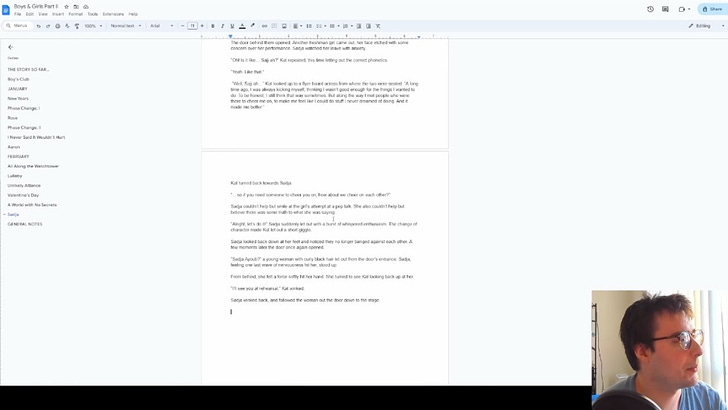My Fiction Writing Process from Start to Finish (Full session, no fluff)
Plus, more links to make you a little bit smarter today.
My Fiction Writing Process from Start to Finish (Full session, no fluff)
The Biology Behind Why We Like Stories
Here’s an idea: What if I told you that the reason we all identify with similar media is because of an ancient system within human biology?
How to build branching narrative without breaking the bank
Freelance game writer and narrative designer Nessa Cannon wants devs to know they can craft meaningful narrative choices without overscoping.
RiskLabs: Predicting Financial Risk Using Large Language Model Based on Multi-Sources Data
The integration of Artificial Intelligence (AI) techniques, particularly large language models (LLMs), in finance has garnered increasing academic attention. Despite progress, existing studies predominantly focus on tasks like financial text summarization, question-answering (Q&A), and stock movement prediction (binary classification), with a notable gap in the application of LLMs for financial risk prediction. Addressing this gap, in this paper, we introduce RiskLabs, a novel framework that leverages LLMs to analyze and predict financial risks. RiskLabs uniquely combines different types of financial data, including textual and vocal information from Earnings Conference Calls (ECCs), market-related time series data, and contextual news data surrounding ECC release dates. Our approach involves a multi-stage process: initially extracting and analyzing ECC data using LLMs, followed by gathering and processing time-series data before the ECC dates to model and understand risk over different timeframes. Using multimodal fusion techniques, RiskLabs amalgamates these varied data features for comprehensive multi-task financial risk prediction. Empirical experiment results demonstrate RiskLab’s effectiveness in forecasting both volatility and variance in financial markets. Through comparative experiments, we demonstrate how different data sources contribute to financial risk assessment and discuss the critical role of LLMs in this context. Our findings not only contribute to the AI in finance application but also open new avenues for applying LLMs in financial risk assessment.
Predicting Mergers and Acquisitions: Temporal Dynamic Industry Networks
Merger and Acquisition (M&A) has increasing importance over market consolidation and reconstruction. For companies who decide to acquire other firms, M&A is a major investment practice, while one of the major incentives to trigger a M&A is obtaining complementarity to enhance its market power among a competitive local industry. Besides the intrinsic factors that have been widely considered in the existing empirical studies, the M&A behavior of a firm is actively influenced by the M&A behaviors of their peer firms, called “peer effect”. However, existing research fails to capture such rich inter-dependencies of M&A events in the industry network. Also, a favorable M&A predictive model should be able to make fine-grained deal-level predictions and do not require ad-hoc feature engineering. This kind of model can provide precise predictions of rival firms’ M&A behaviors and M&A recommendations for specific bidder companies and target companies. Yet most existing works can only predict the behavior of one side of MA deals, which fail to make deal recommendations specific to a firm. Plus, most existing predictive works also require ad-hoc truncations of the data, which transfer continuous time information to adhoc truncations. The information loss caused by transformation is harmful to predictive performance. Because the transformation is laborious and arbitrary, this makes those models hard to apply in the real-world scenario. Finally, due to the sparsity of MA events, existing deal-level predictive models require ad-hoc data rebalance which brings bias to the model. This may further harm the performance and reliability of the predictions. To address these limitations, we propose a MA predictive model based on Temporal Dynamic Industry Network (TDIN). Our method is based on temporal point processes and deep learning methods. The deep learning models enable our model to capture the rich interdependencies among MA events. Our method is also able to make fine-grained deal-level predictions without ad-hoc feature engineering and data rebalance: the temporal point processes model the sparsity of events inside its intensity function. Evaluation results show the superiority of our method, on the basis of the MA cases between January 1997 to December 2020.
Stock Recommendations for Individual Investors: A Temporal Graph Network Approach with Mean-Variance Efficient Sampling
Recommender systems can be helpful for individuals to make wellinformed decisions in complex financial markets. While many studies have focused on predicting stock prices, even advanced models fall short of accurately forecasting them. Additionally, previous studies indicate that individual investors often disregard established investment theories, favoring their personal preferences instead. This presents a challenge for stock recommendation systems, which must not only provide strong investment performance but also respect these individual preferences. To create effective stock recommender systems, three critical elements must be incorporated: 1) individual preferences, 2) portfolio diversification, and 3) the temporal dynamics of the first two. In response, we propose a new model, Portfolio Temporal Graph Network Recommender PfoTGNRec, which can handle time-varying collaborative signals and incorporates diversification-enhancing sampling. On real-world individual trading data, our approach demonstrates superior performance compared to state-of-the-art baselines, including cutting-edge dynamic embedding models and existing stock recommendation models. Indeed, we show that PfoTGNRec is an effective solution that can balance customer preferences with the need to suggest portfolios with high Return-on-Investment. The source code and data are available at https://anonymous.4open.science/r/ICAIF2024- E23E.



